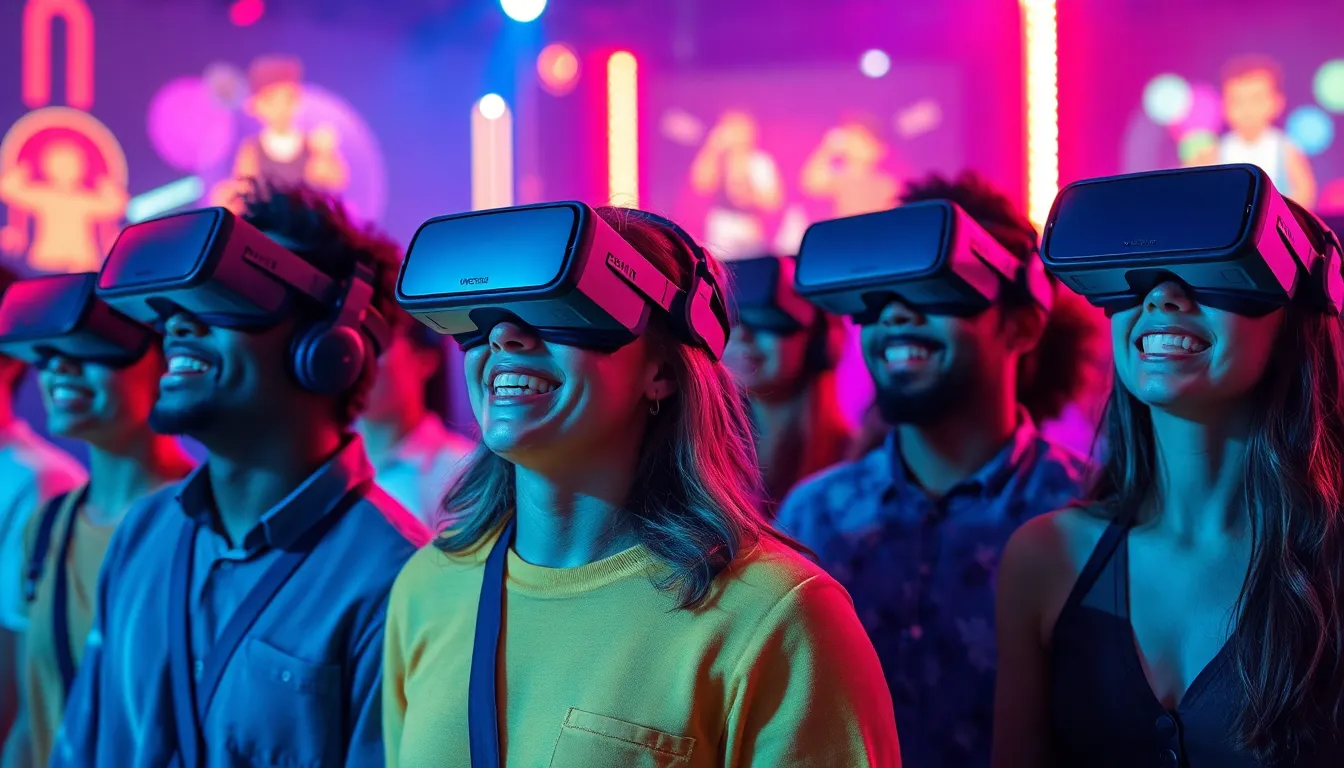Imagine diving into a world where the boundaries of reality blur and entertainment takes on a whole new dimension. VR streaming is not just a trend; it’s a thrilling revolution that’s transforming how people consume content. With headsets that transport viewers to fantastical realms, it’s no wonder everyone wants a piece of this action.
Gone are the days of staring at a flat screen while binge-watching. Now, viewers can sit front row at a concert or explore distant galaxies—all from their living rooms. As technology advances, VR streaming is becoming more accessible, making it the perfect time to jump on this virtual bandwagon. So grab your headset and get ready to experience a new era of entertainment that’s as immersive as it is entertaining.
Table of Contents
ToggleOverview of VR Streaming
VR streaming revolutionizes how audiences experience entertainment. Unlike traditional media, it creates an immersive atmosphere where viewers can feel as though they’re part of the action. Concerts become multi-sensory experiences, allowing fans to feel the energy of live performances without leaving home. Exploring virtual environments also offers unique opportunities to visit places previously inaccessible.
Technological advancements enhance the quality of VR streaming. High-definition graphics, improved frame rates, and minimal latency create fluid experiences that fully engage users. These improvements contribute to a sense of presence, making interactions within the virtual space feel more real.
Accessibility plays a crucial role in the growth of VR streaming. A wider range of affordable VR headsets is available, catering to different budgets and preferences. Platforms that support VR content have increased significantly, ensuring a variety of titles appealing to diverse audiences.
Due to advancements in network infrastructure, streaming VR content becomes smoother. Higher bandwidth capabilities enable the transfer of large data files, which improves the overall experience. This development further encourages users to explore VR streaming options.
Participation isn’t limited to passive viewing. Many VR streaming platforms allow users to engage with others, facilitating social interaction in virtual settings. This social dimension enhances the experience, fostering community among users.
Overall, VR streaming represents a dynamic shift in entertainment consumption. With ongoing innovations, it promises to redefine how individuals connect with content and each other.
Benefits of VR Streaming

VR streaming offers significant advantages that enhance how individuals engage with digital content. It redefines entertainment through groundbreaking technology that immerses users in new experiences.
Enhanced User Experience
Enhanced user experience stands out as a central benefit of VR streaming. Users enjoy high-definition graphics, where every detail captivates their attention. Improved frame rates create fluid motion, enabling seamless transitions in dynamic content. Interactivity also plays a key role, allowing users to influence their surroundings within VR spaces. This level of engagement transforms typical viewers into active participants, making content more memorable. With the availability of user-friendly devices, anyone can step into exciting virtual realities without technical challenges.
Immersive Environments
Immersive environments create deeper connections to content viewers experience. Virtual reality transports users to concerts, art galleries, or epic adventures, replicating the sensation of being there. Various platforms curate diverse settings tailored to different interests, ensuring there’s something for everyone. These environments foster sensation, where users feel sound vibrations and environmental nuances, heightening emotional connections. The freedom to explore places that might be geographically or financially unreachable enhances appreciation for various cultures and events. Engaging with these virtual worlds changes perspectives and enriches everyday entertainment experiences.
Challenges in VR Streaming
VR streaming faces notable challenges that can impact user experience. Two primary obstacles are technical limitations and content availability.
Technical Limitations
Latency issues represent one significant technical challenge for VR streaming. High latency disrupts the immersive experience, creating disconnect between user actions and visual responses. Moreover, bandwidth requirements pose additional hurdles; substantial data transmission is necessary for high-quality VR streaming. Limited bandwidth often results in buffering, diminishing engagement. Device compatibility also presents challenges, as not all VR headsets support the same formats or applications. This inconsistency can frustrate users wanting seamless access to various VR content.
Content Availability
Content availability remains a crucial concern in the VR streaming ecosystem. While many platforms offer VR experiences, the variety and quantity of content lag behind traditional media. Popular titles may be scarce, making it hard for users to find appealing options. Emerging creators can struggle to gain exposure, while established brands typically dominate the market, limiting diverse content opportunities. Additionally, licensing issues can further restrict the range of available experiences. Users may encounter difficulties accessing specific virtual events or experiences that aren’t part of their chosen platforms.
Future of VR Streaming
Advancements in VR streaming technology and industry trends signal a promising future.
Emerging Technologies
AI-driven enhancements create more personalized viewer experiences. Innovations in graphics and display technology improve realism. 5G connectivity plays a critical role by eliminating latency and supporting seamless streaming. Additionally, cloud computing enables access to high-quality VR content without the need for powerful local hardware. These technological breakthroughs enhance overall user engagement, transforming how individuals interact with VR environments. Improved motion tracking also allows for more natural movements within virtual spaces, enhancing immersion across various applications.
Industry Trends
The demand for multiplayer experiences continues to rise in VR streaming. Platforms are prioritizing social interaction, allowing friends to connect in shared virtual environments. Subscription models are gaining traction, offering users diverse content libraries for a fixed monthly fee. More creators are entering the VR space, contributing to a growing array of immersive experiences. Additionally, collaborations between gaming companies and entertainment studios broaden the scope of VR offerings. Increased investment in VR technology indicates strong confidence in its potential, signaling a shift toward mainstream adoption.
VR streaming is set to redefine entertainment as users embrace immersive experiences that engage all senses. As technology advances and becomes more accessible, the potential for VR to transform how people connect with content and each other continues to grow. Enhanced graphics and interactivity foster deeper emotional connections, making every virtual experience memorable.
While challenges like technical limitations and content availability remain, ongoing developments in the industry promise a brighter future. With the rise of 5G and AI-driven enhancements, viewers can look forward to smoother streaming and more personalized experiences. As the landscape evolves, the excitement surrounding VR streaming will undoubtedly inspire more individuals to explore this captivating new world.



